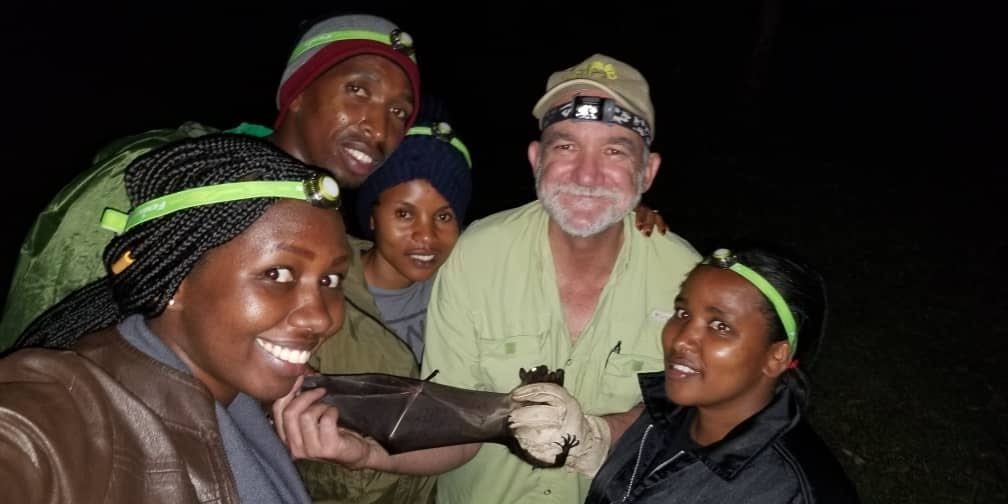BAT RESEARCH AND CONSERVATION PROJECT
Over 54,581 straw-coloured fruit bats have been counted by our team during monthly bat counts at various sites throughout Rwanda. Each time we re-visit these sites we see some of their roost trees being cut down and hear stories of local people trying to chase them away. Through this work we are learning more about the bats of Rwanda and engaging local communities to join us in protecting them.
OUR PROJECT
We are conducting a number of research projects in Rwanda to document the important roles bats play, generate missing information and quantify the ecosystem services. We are studying both insectivorous bats and fruit bats, collecting faecal samples to identify the role they play in seed dispersal and pest control. We are also focusing on the most abundant species of bat in Rwanda, the Straw-Coloured fruit bat (Eidolon helvum) and conducting monthly counts to estimate the number of individuals and colonies. We have fitted some with GPS tags to better understand their movement patterns and roost preferences and to give us information about which habitats need to be protected.
WHY BATS?
Bats provide us with crucial ecosystem services and have an important role as seed dispersers, pest controllers, and pollinators, yet a quarter of all global bat species are known to be threatened due to the loss of foraging habitats and roosts mainly caused by human activities. Despite the rich biodiversity of bat species, they are the least studied when compared to other mammals.
Bats have very important roles and provide us with crucial ecosystem services. For example, insectivorous bats can eat as many as 8,000 tiny insects, like mosquitoes, every night. These bats are important for pest control and can help reduce diseases that are spread by mosquitoes, such as malaria. Fruit-eating bats will pollinate flowers and spread seeds through their droppings. Many fruits such as mango and avocado rely on bats to pollinate them.
Despite their important role as seed dispersers, pest controllers, and pollinators, a quarter of all global bat species are known to be threatened due to the loss of foraging habitats and roosts mainly caused by human activities.
Some people think bats are mysterious, scary or bad luck, but we need bats for many reasons. It is important to help protect them, leave their homes undisturbed, and tell others what amazing creatures they are!
WORKING WITH COMMUNITIES

Raising Awareness
Our research helps us know more about bats in Rwanda, and we then use this information to design relevant conservation actions and measures. People often fear bats or are not aware of their importance or their roles within the ecosystem. We have a number of community engagement activities to raise awareness and educate people about the important role of bats and the need for their protection.
We work with communities living nearby bat habitats to teach them how to live safely with bats. We also conduct large community campaigns with music and loudspeakers in busy public places, engage children in schools and have set up set up bat youth clubs. We have local informants who help us monitor the bats and let us know if roost trees are being cut down or bats disturbed.

We work with experts from around the globe
In addition to our strong team at RWCA, we are privileged to be working with many experts from around the globe to ensure we build the capacity of our staff and guarantee the work we do is of top quality. We are collaborating with Dr. Rodrigo Medellin from Mexico, Dr. Paul Webala from Kenya and Beryl Makori from the East African Bat Conservation Network. We are working in partnership with Max Planck Institute who have supported us in piloting GPS tags on fruit bats and are happy to be connected with Bat Conservation International.
NAPOLEON ISLAND
Lake Kivu is one of a string of freshwater lakes which lie along Africa’s Great Rift Valley and its islands, are a tourism destination in Rwanda for both international and national visitors, known for its stunning lake and hill views. Lake Kivu has many islands, but Napoleon Island (also known as Nyamunini island) is quite special in its rich biodiversity. The island resembles the shape of Napoleon’s hat and is home to as many as 40,000 Straw-Coloured fruit bats (Eidolen helvum), the largest colony in Rwanda. For this reason, the island has become a tourism destination and local people have made a business of boat trips to the island to see bats, hike and enjoy the hill top views.
In the past, the guides would throw stones at the bushes or disturb the bats so that they fly into the sky to create a display for the tourists. There were no clear pathways and the tourists would come very close to the bats, increasing the contact risk and disturbing the habitat. As the island became more popular, we worried about the level of disturbance and were concerned that the bats might choose to move to other areas.
We are now working with the boat drivers and guides to promote the need for sustainable ecotourism to enable their work to grow without endangering the bats. We have made a plan for designated walking trails, information boards and other conservation friendly developments to promote the island as an ecotourism opportunity. We have also delivered a training with the boat drivers and guides to raise awareness of conservation and living safely alongside bats.